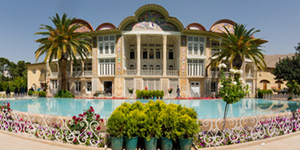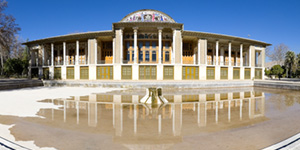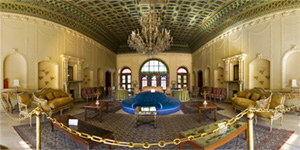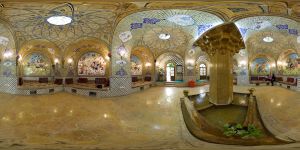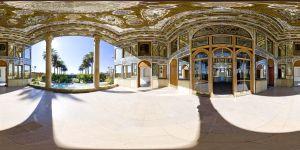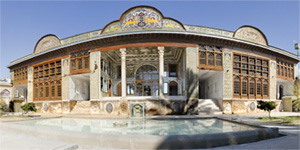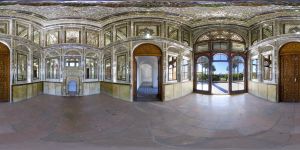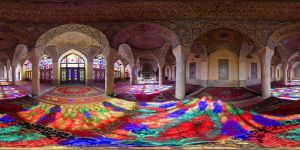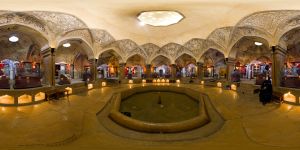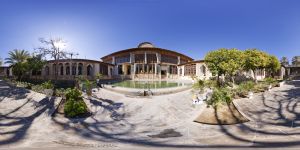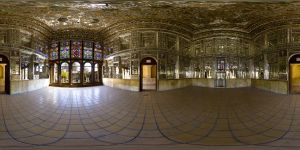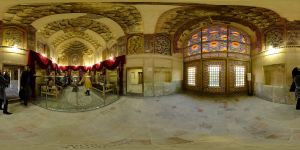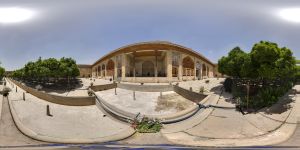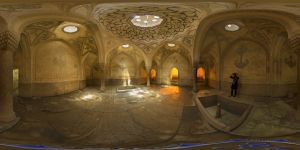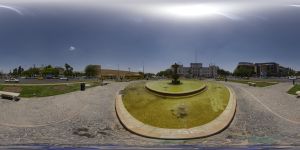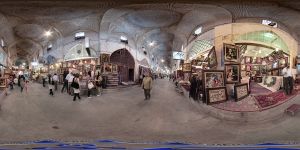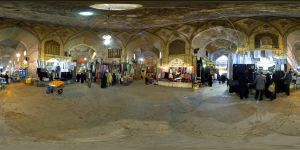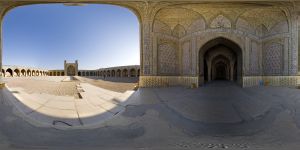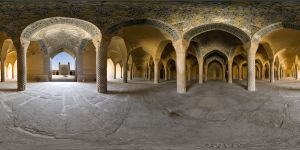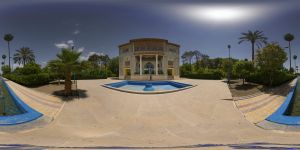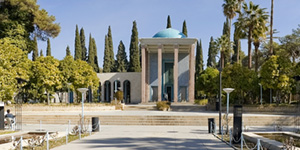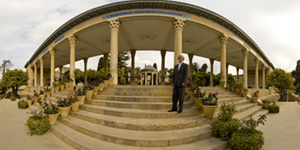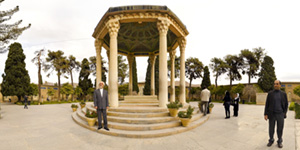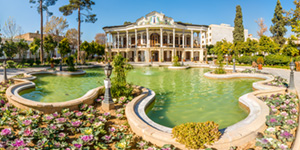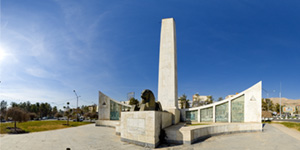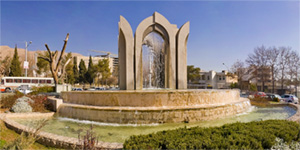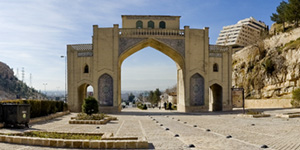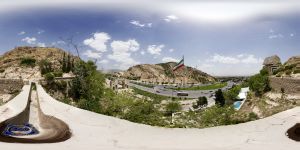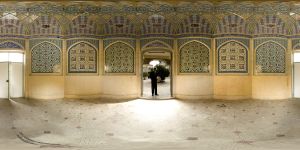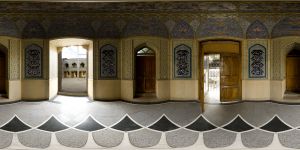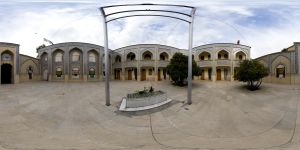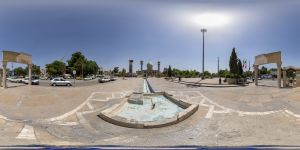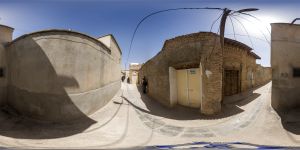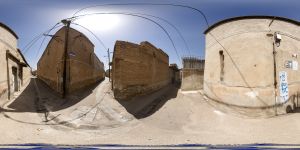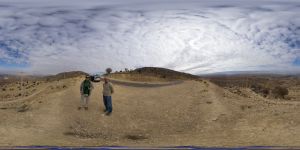

Currently 36 Panoramas in This Gallery
See the beautiful city of Shiraz in fullscreen panoramas. Shiraz, one of Iran's oldest cities and the fourth biggest in the country, has been the capital of Persia (current Iran) during the Zand dynasty and hosts quite a few interesting historical sites.
Shiraz is known as the city of flowers and nightingales, refering to its beautiful gardens and two very famous poets; Sa'di and Hafez. There are quite a few beutiful mosques and other historical buildings showing the beutiful architicture, tile works and mirror tile works.
Shiraz is also famous for its grapes and according to the tradition known for its wine in the past. The city has given its name to the grapes (and subsequently wine) oriningated from here. All this plus the good atmosphere and friendly people make this sunny city well worth a visit, if not in real, as virtual reality panoramas.
"Bagh-e Eram" (Garden of Eden) is a historic garden in Shiraz and one of the most beautiful & exceptional examples of Persian Gardens with the quadripartite structure with focal water feature, connecting aqueducts, and surrounding trees, as well as the placement of the palace. It has many typical tall cypres trees. It was originally built during the middle of nineteenth century by the Ilkhanate or a paramount chief of the Qashqai tribes of Pars.
Today Eram Garden and Qavam House are within Shiraz Botanical Garden of Shiraz University. The garden is a World Heritage Site & protected by Iran's Cultural Heritage Organization.
A former palace built in 1863, a Persian garden, and currently also housing a weapon museum.
Originally Golshan Garden, constructed at the request of Mohammed Khan Qavamol-Molk about two hundred years ago. The current main building was constructed by Mirza Ali Mohammadkhan Ghawam II in 1863. After his death the garden was eventually inheritted by Afife, thus being called Afif Abad.
The garden is a beautiful example of a Persian garden and the palace's cellar is used as a weapon museum. There is a beutiful spa part in the garden, which is converted to a café for visitors today.
A former palace built in 1863, a Persian garden, and currently also housing a weapon museum.
The current main building was constructed by Mirza Ali Mohammadkhan Ghawam II in 1863. After his death the garden was eventually inheritted by Afife, thus being called Afif Abad.
This is part of the original relax/spa part adjacent to the palace's bathroom. Nowadays it is used as a café (tea house) for the palace's visitors.
The vaulted alcoves have beautiful tile paintings, illustrating different story scenes from Shahnameh, the national epic of the cultural sphere of Greater Persia by the Persian poet Ferdowsi.
Among the stories are:
The battle of Rostam and Esfandiyar, Rotam killing the White Demon, Simurgh coming to Rostam's aid in battle, Duel of Rostam and his son Sohrab.
Built 1879-1886, was the home of Governor's Court of Fars during the Ghajar period. Significantly represent Iranian Architecture during Ghajar period. Since 1998, the complex is used by the faculty of Art and Architecture of Shiraz University.
Built 1879-1886, was the home of Governor's Court of Fars during the Ghajar period. Significantly represent Iranian Architecture during Ghajar period. Since 1998, the complex is used by the faculty of Art and Architecture of Shiraz University.
Naranjestan Ghavam, Shiraz, Iran. Built 1879-1886, was the home of Governor's Court of Fars during the Ghajar period. Significantly represent Iranian Architecture during Ghajar period. This has been the main reception room. Since 1998, the complex is used by the faculty of Art and Architecture of Shiraz University.
Naisr al Mulk mosque is a traditional mosque with one of the most beautiful tile works and architecture typical from the Ghajar era with extensive colored glass wrok in its decoration. The mosque was built 1888.
Vakil bath house (Hamam Vakil) has been an old public bath house built during the Zand dynasty in second half of 18th century. It was a part of the royal district constructed during Karim Khan Zand's reign, which includes Arg of Karim Khan, Vakil Bazaar, Vakil Mosque and many administrative buildings.
Here is the entrance hall of the bath house where the shoes and cloths were changed before entrance to the bathing area. The building is used as a museum today.
Originally the private house of Ghavam's sister Zinat-ol-molouk (Zinat-ol-molk) and later the residence of the court governor of Fars province in Ghajar period.
It is a beautiful house in traditional style with a court yard in the middle and the rooms around the court yard. The rooms are richly decorated with wall and ceiling paintings or mirror tile work.
Originally the private house of Ghavam's sister Zinat-ol-molouk (Zinat-ol-molk) and later the residence of the court governor of Fars province in Ghajar period.
It is a beautiful house in traditional style with a court yard in the middle and the rooms around the court yard. The rooms are richly decorated with wall and ceiling paintings or mirror tile work.
Arg of Karim Khan (or Arge Karim Khan) is a citadel built during the Zand dynasty of Persia around 1800 CE. It is named after the dynasty's king Karim Khan, who also used it as his residence. It has four circular towers at its corners. Inside the Arg, there are different buildings, the north building was used in the winter, the south building for summer use, and west building was four all seasons. Outside of the building has simple presentation but on the contrary inside the rooms have beautiful decorations which is the characteristic of buildings during Karim Khan.
The court yard of Arg-e Karim Khan compound in front of the main reception hall and it's iwan. Unfortunately there is no water in the fountain and the aquaduct at the time of the photography.
The private hamam (bath house) inside Arg-e Karim Khan compound.
Arg-e Karim Khan walls and towers outside view, seen from Shahrdari square.
Bazar Vakils carpet market, restored part of the old bazar with many carpet shops. Hand woven carpets of highest quality framed as paintings on the display of several shops.
A traditional bazar built several centuries back. It comprises arched alcoves with wide platforms in between, and seventy-four high and well-proportioned arches sustaining the roof, and there is a high domed crossing, where the east and west bazars diverge from the main bazar.
Built 1751-1773 during the Zand Dyansty, is the most impressive building of the Vakil buildings. The mosque, like other Karim Khan Zand structures, is so solid that even after two violent earth quakes it stands as firm and solid as ever.
The mosque's Shabestan (evening prayer hall) with an area of 2700 sq.m. contains 48 simillar tall pillars of stone with a beautiful ceiling and a marble altar that is considered to be one of the master pieces of the Zand era. The night prayer hall is supported by 48 monolithic pillars carved in spirals, each with a capital of acanthus leaves.
Bagh-e Delgosha, the Garden of the Heart's Delight, another example of the Persian gardens in Shiraz, was made in the eighteenth century. It is in an orange grove near Boustan avenue, which leads to the tomb of Sadi. Some of the walks are lined with cypress trees with blue painted water channels. The main building which has three stories with two entrances in two sides and a porch in the middle floor with a view of pool is a sign of glorious days.
The famous poet Saadi's (Sadi, Sa-di) Mausoleum. Marble tomb dates from 1860s, an octagonal shaped building, walls inscribed with Saadi work in tile. The tomb of Saadi, the poet and mystic of 13th century western (about 207-1291). He is recognized not only for the quality of his writing, but also for the depth of his social thoughts. The following poem of Saadi is inscribed at the entrance to the Hall of Nations of the UN building in New York:
Of One Essence is the Human Race,
Thusly has Creation put the Base.
One Limb impacted is sufficient,
For all Others to feel the Mace.
The Unconcern'd with Others' Plight,
Are but Brutes with Human Face.
Garden of the famous poet Hafez tomb. Several rectangular pools have been added amongst the gardens, and well-maintained orange trees, paths, streams, and flower beds create a pleasant environment for the tourism hub of Hafez's tomb and memorial hall. A tea house on the grounds provides refreshments in a traditional setting. The dome over Hafez's grave is well-lit at night, providing an attractive focal point.
The famous poet Hafez tomb. The Tomb of Hafez and its associated memorial hall, the Hafezieh, are two memorial structures erected in the northern edge of Shiraz, Iran, in memory of the celebrated Persian poet Hafez. The open pavilion structures are situated in the Musalla Gardens on the north bank of a seasonal river and house the marble tomb of Hafez. The present buildings, built in 1935 and designed by the French architect and archaeologist André Godard, are at the site of previous structures, the most well-known of which was built in 1773. The tomb, its gardens, and the surrounding memorials to other great figures are a focus of tourism in Shiraz.
Shapouri Pavillion and Garden or "Khane-ye Shapouriha" (The Shapouri's House).
As the first city in Iran to have natural gaz pipes to all homes, a monument were built at this square with a "ever" burning gaz flame as a symbol. The square was simply named "Gaz Square", as landmark in Shiraz. The flame is not burning any more but the monument and the gaz pipes to homes are still there.
Eram Square with the Eram garden and Eram palace at one side and the university dorm facilities at another is just at foot of a road to the highest place in Shiraz where in the past you could get a good view over the city.
Quran Gate (or Darvazeh Ghor-an), the ancient gated entrance to Shiraz from north. Karim Khan added a room at the top of the gateway to house a holy Quran so people when leaved the city they passed under the Quran (now the Quran is kept in Pars Museum) to be blessed for a safe trip. The complex also includes tomb of Khaju-ye Kermani, the poet contemporary to Sa-di. Climb up the hill to the tea house. The view of Shiraz is breathtaking from this spot. Has a spectacular view at night.
Another view of the Quran Gate with view over Quran Square and Shiraz view from the an elevated point
Theological School of late Mr. Madjd Eddin Mahallati, built 1984, Shiraz, Iran. While relatively not old at all it is built in traditional Islamic style with exquisite tile works.
Theological School of late Mr. Madjd Eddin Mahallati, built 1984, Shiraz, Iran. While relatively not old at all it is built in traditional Islamic style with exquisite tile works.
Theological School of late Mr. Madjd Eddin Mahallati, built 1984, Shiraz, Iran. While relatively not old at all it is built in traditional Islamic style with exquisite tile works.
Sayyed Allaeddin Hossein Mosque or more know as Astaneh as common name for both the shrine and the square and the area in general.

